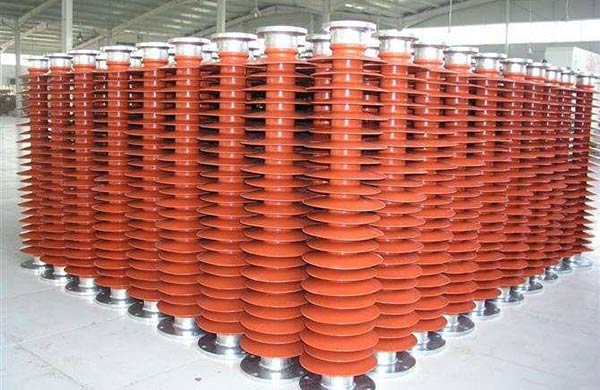Post insulator products consist of the iron cap, tempered glass parts, and steel feet, and are glued together with cement. The product all adopts the most advanced international cylindrical head structure, which is characterized by small head size. Lightweight, high strength, and large creep age distance. It can save metal materials and reduce the cost of the line. In order to meet the needs of live operation, the traditional domestic structure shape is adopted on the brim of the cap.

Indoor post insulator is used for rated voltage 6~35kV indoor power station, substation distribution devices, and electrical equipment to insulate and fix conductive parts. The insulator is suitable for ambient temperature from -40℃ to +40℃, and the altitude of the installation site should not exceed 1000 m for common type and 4000 m for plateau type. And the insulator is divided into three types of a structure according to the adhesive structure: external adhesive, internal adhesive, and joint adhesive.
The tempered glass insulator has the feature of zero value self-breaking. It can be observed on the ground or in the helicopter, so there is no need to climb the pole to inspect piece by piece, which reduces the labor intensity of workers.
The products introduced into the production line by ZMS Cable Company have an annual operating self-breakage rate of 0.02-0.04%, which can save the maintenance cost of the line. Good performance of arc resistance and vibration resistance.
The new surface of the glass insulator suffering from lightning burns in operation is still a smooth glass body with the toughened internal stress protection layer, therefore, it still maintains sufficient insulation parts energy and mechanical strength.
In the 500kv line, many times occurred in the wire track ice caused by the dance of the disaster, subject to the wire dance after the glass insulator tested, electromechanical performance did not decay.
Good self-cleaning performance and not easy to age
According to the power sector generally reflects the glass insulator is not easy to accumulate dirt and easy to clean, the southern lines running glass insulator after the rain rinsed clean.
Glass insulators on lines in typical areas are regularly sampled to determine the mechanical and electrical properties after the operation. From the accumulated data of thousands of years, it shows that the electromechanical performance of glass insulators after 35 years of operation is basically the same as that of the factory, and no aging phenomenon has occurred.
The large main capacity of insulators made by ZMS, the uniform voltage distribution in bunches, and the dielectric constant of glass 7-8 make the tempered glass insulators with large main capacitance and uniform voltage distribution in bunches, which are conducive to reducing the voltage borne by insulators near the wire side and grounding side, thus achieving the purpose of reducing radio interference, reducing corona loss and prolonging the life of glass insulators, which is proved by operation practice.
Our toughened glass insulator types: standard type, dirt-resistant type, DC type, spherical type, aerodynamic type, ground type, for electrified railway contact network.
Performance
The basic properties of insulators include electrical, mechanical, and thermal properties. In addition, there are environmental resistance and aging resistance.
1. Electrical performance: The destructive discharge along the insulating surface is called flashover, and the flashover characteristic is the main electrical performance of insulators. For different voltage levels, insulators have different requirements of withstanding voltage. The indicators are frequency dry, wet withstand voltage, lightning shock withstands voltage, lightning shock cutoff voltage, operating shock withstand voltage, etc.
In order to avoid a breakdown in operation, the breakdown voltage of insulators is higher than the flashover voltage. In the factory test, the breakdown type of porcelain insulators is generally subjected to spark test, i.e. adding high voltage to make frequent sparks occur on the insulating surface, maintaining a certain time to see if they are broken. Some insulators also need to go through corona test, radio interference test, partial discharge test, and dielectric loss test, etc.
In insulators in high-altitude areas, the electrical strength decreases due to the decrease of air density. Therefore, the withstand voltage should be increased accordingly when converted to standard atmospheric conditions. The flashover voltage of the dirty insulator when it is damp is much lower than its dry and wet flashover voltage. Therefore, the fouling area must strengthen the insulation or use the fouling-resistant insulator. Its creep age distance (creep age distance and rated voltage ratio) should be higher than the normal type. Compared with AC insulators, DC insulators have poorer electric field distribution, adsorption of dirt particles and electrolysis, lower flashover voltage, and generally require special structural design and larger creep age distance.
2. Mechanical properties: insulators in operation are often subject to gravity and tension of the wire, wind, ice weight, insulator self-weight, wire vibration, equipment operation mechanical force, short circuit electrodynamics force, earthquake, and other mechanical forces. The relevant standards have strict requirements for mechanical performance.
3. Thermal performance: Outdoor insulators are required to have the ability to withstand rapid temperature changes. For example, porcelain insulators are required to undergo several cold and hot cycles without cracking. Insulation casing because of the current through, the temperature rise of its parts, and insulating parts and the allowable short-time current value must be in line with the relevant standards.
